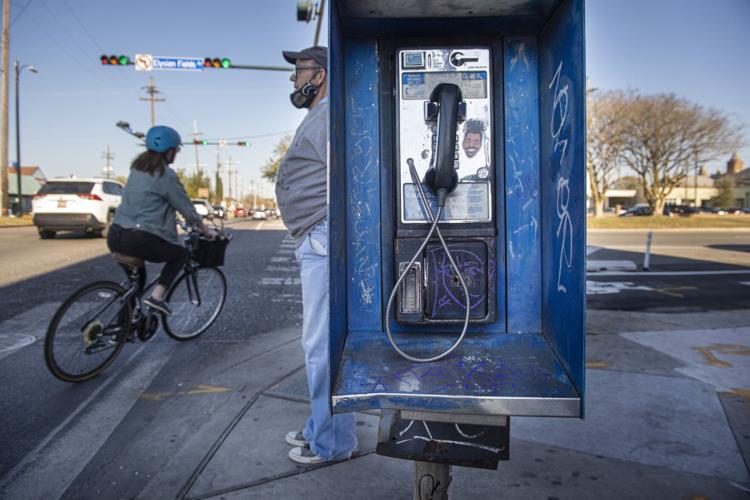The faded blue boxes, often covered in graffiti, stand at dozens of intersections across New Orleans, rusted by weather and time.
The pay phones that used to be inside are mostly absent. Some are covered in cement. A few receivers remain, though lifting them from their hooks usually doesn't produce a dial tone.

An old pay phone stands on Elysian Fields Ave. in New Orleans on Monday, March 8, 2021. (Photo by Chris Granger | The Times-Picayune | The New Orleans Advocate)
But soon enough the pay phone kiosks, relics of a century when people carried around loose change to make calls instead of smartphones, will disappear from public-rights-of-way for good.
City Hall officials announced last week that they have asked a contractor to remove the 77 boxes they know about out of their concrete and dirt bases.
Taking them down will improve the aesthetics on public avenues and boulevards, they said.
“Removing these outdated kiosks is a big quality-of-life win for residents who live in these neighborhoods," said city Deputy Chief Administrative Officer Ramsey Green.
On any given day as she drives down Almonaster Avenue, Renee Cambrice can spot heaps of crumbled Styrofoam cups, crushed beer cans and empty p…
For more than a century, a neighborhood pay phone was a public amenity, just as useful and ubiquitous as a U.S. Postal Service drop box.
But nobody much uses them anymore. Roughly 96% of Americans own cell phones, according to the Pew Research Center, and most own smartphones that double as hand-held computers.
Major phone companies don't want the hassle of maintaining phone booths either, and in recent years city officials across the U.S. have been clearing out the few that remain. Last year, New York City officials announced they would remove the 3,000 pay phones still remaining across the five boroughs, citing complaints from residents and the need to free up sidewalk space.
Can't see the map below? Click here.
In New Orleans, the push to remove the boxes began when Michael Burnside, a Central City resident, got sick of seeing them and other eyesores in his neighborhood.
Two years ago, Burnside asked representatives from two City Council offices to tour his neighborhood and see its problems. Though the dilapidated kiosks were a small thing, the group soon decided that hauling them away "was something we could actually do that would sort of change the tenor of hope," Burnside recalled.
But first the city had to figure out who owned them. Though AT&T once managed the phones, the communications giant offloaded them in 2008 to independent operators, citing a desire to get out of the pay phone business before it became unprofitable.
The New Orleans City Council backed rules on Thursday requiring property owners to keep their grass 8 inches shorter than current rules permit…
A search of the city's franchise records showed that a smaller company, Mid City Pay Phone, last managed many of the devices. When a letter sent last summer to Mid City's last-known address went unanswered, the city began moving to pull the kiosks off of public-rights-of-way, City Councilmember Helena Moreno's Chief of Staff Andrew Tuozzolo said.
A contractor, Hard Rock Construction, has been paid $60,000 to complete the job. Its crews will replace any concrete damaged by the removals. Phone boxes on private property won't be touched.

An abandoned pay phone that is leaning down toward the ground on Martin Luther King Jr. Blvd. in New Orleans on Monday, March 8, 2021. (Photo by Chris Granger | The Times-Picayune | The New Orleans Advocate)
That means there are still a few options for anyone with a dead battery and some spare change — who can also remember the number of the person they want to call.
Elizabeth Gaytan owns what is likely one of the last pay phone companies in the New Orleans area, Americoin. Gaytan bought Mid City's private inventory when it went belly-up years ago, along with J. Miller Enterprises' booths when that company shuttered for good, she said.
"It’s a dying business. And the ones I still have are ones where customers pay me to have the phones there," she said. A retired BellSouth employee, Gaytan, 74, knows how to run the computer system that gives each phone its dial tone.
Americoin has three or four working phones still left in New Orleans, mostly along Claiborne Avenue on gas stations and on other private property. Others in its stock are inoperable, and Gaytan said she's been removing them little by little.
The blue booths on public neutral grounds "belong to the city," Gaytan added.

An old pay phone on Elysian Fields Ave. in New Orleans on Monday, March 8, 2021. (Photo by Chris Granger | The Times-Picayune | The New Orleans Advocate)
In a statement, Moreno said that finally removing the phones will help beautify some neighborhoods. "Picking up these disconnected pay phones is just one small way to show respect for our neighborhoods and make progress toward more inviting public spaces," she said.
The first 10 will be pulled out of Central City and made available to buyers at the city's April public auction. The remaining 67 will be removed in the coming months, city officials said.
Baton Rouge a pilot site to use a free mobile tracking system letting public log type, location of litter
Burnside said that the two nearest to his South Liberty Street home — one on Martin Luther King Jr. Boulevard and another on Simon Bolivar Avenue — were removed Tuesday. He hopes artists will buy them and turn them into something eye-catching.
"Somebody could make a complete joke, take one of these out there to wherever the old Beauregard statue was," he said, a display similar to the Mardi Gras Indian suit that was installed on the base of the former Jefferson Davis monument on Fat Tuesday. "That’s the kind of city we are."
Residents who wish to report additional locations of abandoned pay phone kiosks may report them to 311.
See the list of known locations of the abandoned kiosks.









